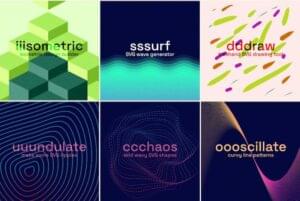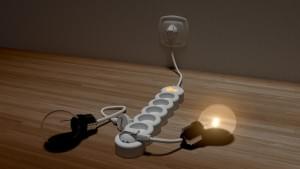There are several ways to handle the graphics required for a Website. The first, and easiest, is to simply steal — er, “borrow” — them from other sites. Honest designers and cyberbanditos alike use this method, in lesser or greater form. In some cases, it’s not a problem. Either the Website owners don’t mind, or they’ve used graphics from freebie sites. In other cases, it’s no different than stealing a loaf of bread from the corner store. When in doubt, you should probably err on the side of caution and avoid using any graphics that aren’t explicity for public use (I’m currently preparing a column for SitePoint on this very topic, by the way). But no matter how you look at it, the copyright issues basically mean that your selection’s limited to images that other people have already used.
The second method is to either have professional or amateur graphic designers make the graphics for you, or to download pre-made images from graphics sites that supply them specifically for this purpose. The third is to make them yourself. Here’s where many people who want a Website of their own fall short. Either they’re confused by sophisticated (read: “hard-to-use”) commercial programs, or they’re foiled by the limitations of cheaper, less effective packages.
Two shareware programs on the market, My Web Toolbox 3.3 and Trellian Button Factory 2.02, fill part of the need. They provide an inexpensive way to create buttons and similar graphics for Websites. Neither one is as comprehensive, sophisticated, or expensive as the Photoshops, Paint Shop Pros, and Flashes of the world, and neither one attempts to be. Instead, they strive to do one particular thing, and do it well. How well they succeed, at least in my opinion, is considered here.
Note: These reviews appeared in earlier and slightly different forms as Newsletter #13 for my Web site, Troubleshooting and Resource Guide for Windows 95/98/ME, at www.toejumper.net. The newsletter was forwarded to both software creators for their responses, which have been incorporated here.
My Web Toolbox 3.3 $30
www.australianwineandbeer.com/mwt/toolbox.htm
My Web Toolbox is the work of an Australian software creator, Ian Timmins. Ian markets MWT through a wine and beer site, which may be one reason why he doesn’t receive as much exposure as he might. That’s unfortunate, because MWT is a little gem of a program. He’s currently considering cranking up his attempts to market the program, and has one eye out for suitable business partners (a word to the wise, if you will).
To quote the creator, “The concept behind my button option is to offer a limited range of styles, but to make sure those styles can be created quickly and simply.” Indeed the range of styles available in MWT is limited, but the creation of buttons and banners couldn’t be easier. I reviewed version 3.2, but version 3.3 is now available, and supports frames for animated banners. As noted on the site, MWT doesn’t create the actual animated graphics; you need a separate program for that function. Only GIF files can be animated, and MWT doesn’t support GIFs, for reasons detailed below.
Installation
MWT is quite well-featured for such a small download, and it’s easy to use as well. The program itself opens in a small toolbar that can be docked anywhere on the screen, keeping it out of the way until needed. It can also be reduced to an icon in the System Tray. MWT is simple to install and barely impacts your system: the program doesn’t intrude on the registry, the system configuration, or anything else. And, to uninstall it, simply delete the program from your hard drive. I appreciate this feature. I get irritated with programs that strew registry entries through your system, intrude on your Start Menu, rewrite your configuration files, and so forth. It isn’t necessary. As Ian says, “[P]robably my greatest hate with most shareware is when it deposits rubbish in the registry, which, usually, is never removed. I simply won’t run shareware now that requires installing.” I like the way this man thinks.
What it Does
MWT creates, edits, and modifies images (buttons and banners) for Websites. Unfortunately, the program only creates BMP and JPG files, not GIFs. This is a loss, but the reasoning has to do with Unisys’s purported ownership of the GIF format and the possible legalities affecting programs that create GIF files without paying ransom to Unisys. The disadvantage of using BMP files on Websites is twofold: they tend to be much larger than comparable JPG and GIF files, and Netscape is twitchy about supporting them.
The MWT toolbar consists of twenty buttons, with more possibly being added in the future. Each button has its own function, and most are self-explanatory. The color selections are quite extensive, with the option to choose from 24-bit, HTML, browser-specific, and full-spectrum palettes. The icon button lets you view and create icon images. Conversion from BMP to JPG and vice versa is a one-button operation, as is:
- font selection and preview,
- special character display,
- capturing and copying all or part of a screen,
- slicing images into smaller chunks,
- value conversion (binary, octet, decimal, and hex), and
- viewing files in ASCII and/or hex format.
The modification of previously created images isn’t quite as simple as creating your own buttons from “scratch” (which is actually creating buttons from templates), but there’s nothing difficult about doing either one. The only drawbacks to creating new buttons are the small number of templates available — basically ten basic shapes that can be altered more or less as desired — and the limitations on the size of buttons. Added attractions include the ability to create banners, composite images, and colorized HTML fonts (including spectrum and random colorizations). The templates are all rectangular or square, though the actual graphical designs are often circular, oval, and so forth. Background colors must be chosen carefully to closely match the Web page they will go on, as no transparency option is available (no GIFs, no transparency). You do have the ability to import your own background image for the button, and this might be a better way to integrate the buttons into your site (Ian says that he believes BMP files can be made transparent, by masking the bottom left pixel).
The Wrap-Up
Overall, MWT is a small but excellent program that concentrates on a single task — button creation — and does it very well. That’s not exactly true: as Ian points out, “More users actually use the program for the colour selection options, rather than the button creation option. In fact, button creation came late in the development of the program (which started out simply as a colour selection program). But then the colour selection options aren’t restricted in the shareware version, whereas button creation is.”
More options than you would expect are available, and the additional capabilities of screen capturing, HTML colorization, and banner creation only add to this program’s value. The limited number of button templates is a concern, but not enough to warrant my steering you away from this program. My suggestion is to grab it and register it now, before some commercial entity scarfs up Ian’s little creation, adds some bells and whistles, and jacks the price up.
Trellian Button Factory 2.02 $45
Trellian is a well-known software development company, also based in Australia. Besides the Button Factory, they also market other Web tools, including an FTP client, a search engine submission utility, and an ecommerce platform. TBF is available as a free demo version, and as a fully functional registered version. The demo version times out after 30 days and does not allow you to save any images; in this sense, it is more of a trialware than a full shareware program. As the name says, this program does nothing but create buttons for Websites. It gives you plenty of styles and options to choose from, though as with My Web Toolbox, you’re limited to the templates provided (and this program provides a tremendous number). Trellian was also provided with the newsletter version of this review, and their response was simply, “Sounds good!”
Installation
TBF installs quickly, using a standard installation wizard, and can be uninstalled through the Add/Remove applet. Opening TBF gives you a full screen with a Daily Tip (which can be disabled) and two toolbars that feature many of the standard buttons we’ve grown accustomed to — New, Open, Cut, Copy, Paste, etc. TBF is not nearly as self-explanatory as My Web Toolbox, and may prove intimidating to the novice Web designer. To my eye, it has some of the look and feel of the big boys, particularly Paint Shop Pro – and those experienced with PSP, Photoshop, or another such program will feel more at home. Virtually no offline help is available: a link to the Online Manual sends you to a Trellian Website that provides a good amount of help. I strongly advise new users to go through this material first, as there’s plenty of helpful info and tips here, though not all of the options are satisfactorily explained. The toolbars at the top are somewhat dockable, though they can’t be dragged and dropped just anywhere. Additionally, a Properties menu is available by right-clicking, or through the top menu.
What it Does
Most of your work will be done in the main, blank space, called “the work bench.” The program is template-driven; all of your work will be based on one template or another. You’ve got lots of options to change and modify the templates — size, shape, border, background color, etc. — from both the toolbar and the Properties menu, which are accessible by right-clicking. The templates themselves are varied and quite beautiful, with some very sophisticated graphic designs available (if I count correctly, this version comes with 125 selections). In addition to the fancier choices, some plainer, more basic templates are provided, including ones that are designed to fit in well with standard Windows, Mac, Linux, and Unix graphical schemes.
The easiest way to create a button is to open the Image Library (through Window, Show Library, which displays the entire library’s contents in a narrow right-side pane) and drag a selected button style onto the work bench. Once on the work bench, a button template can be modified and resized as desired. A full-color palette makes color choices very extensive and easy to work with. The program lacks a multiple undo, so you can only go back one step in the creation process. You can, however, use the Delete button to get rid of creations that you don’t want and start over with a fresh template.
All the images are rectangles or squares, though many of the designs themselves are ovals, circles, arrows, and so on. You’ll have to assign a background color that closely matches your Web pages’ background color or image in order for the button to blend in, or import the same background image that you use in your Web pages. Note that the background color choice is reflected over the entire work bench, so don’t let that throw you.
Like My Web Toolbox, TBF does not support GIFs. It does, however, support BMP, JPG, PNG, and PPM (Portable Pixelmap File) formats, along with the proprietory TBF format (primarily useful for saving works in progress). Since the program does not support GIFs, backgrounds can’t usually be transparent (PNG images can be variably transparent, but it isn’t a simple matter of clicking a button; see the PNG home site at www.libpng.org/pub/png/ for more information). I imagine Trellian’s rationale for not supporting the GIF format is similar to that of MWT’s creator. There is a transparency option in Properties, but this doesn’t make a color transparent in the accepted sense of the word; instead, it blanks out the entire template, leaving only the text and the background color.
It took me a while to figure out how to alter the text in a template. The instructions provided in the Online Manual are wrong, wrong, wrong — according to the instructions and the provided image, there’s a text box in the Toolbar that you can enter your new text into. Nope. However, what does work is to highlight the image and then double-click on it. Your image “disappears” and a blank, white field appears into which you can type your new text. Clicking outside the text field/image brings the image back, with your new text included. It is quite easy to change and resize your text, and you have a large number of fonts to choose from. As far as I can tell, the New Text option gives you a button with no graphics inside except for the basic background color — a useful choice for Web designers who know what to do with such an option (and similar to the Transparency option detailed above). TBF does not provide for banner creation per se, but with the Resize option, I see no reason why you can’t make a button big enough to serve as a banner image.
TBF gives you a straightforward way to create clickable image maps, as outlined in the Manual. However, from what I can tell, you can only assign a single URL to a particular image — no slicing an image into chunks and assigning different URLs to each piece.
Saving a creation is a bit tricky; choosing Save As only allows you to save the button as a .TBF file. If you highlight the button and choose File, Export, you can choose from the other four formats. Again, a study of the Online Manual is helpful here. Some of the fancier options, such as choosing grid size, creating new frames, etc., aren’t well explained; you’ll either have to figure them out on your own or extrapolate their meaning from your knowledge of other graphics programs.
The Wrap-Up
In summation, Trellian’s Button Factory is an excellent program that can create sophisticated Web buttons quickly and with minimal effort. The learning curve is steeper than with My Web Toolbox, but the program gives you some functions and options that MWT lacks. I’m not altogether happy with the sometimes counter-intuitive way the program is set up to operate, and I’m disappointed in the Online Manual’s lack of documentation on a number of features. However, the program does what it sets out to do very well. The huge variety of button templates and sophisticated array of tools makes the Button Factory a worthwhile purchase for serious Web designers.
Mike is an educator, freelance writer, and self-taught PC user who maintains a Windows resource site at ToeJumper. His hobbies include basketball, politics, and spoiling his cats.



